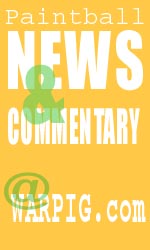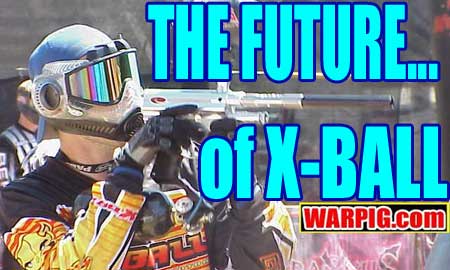  |
|
|
|
|
|
|
  |
|
|
|
|
|
|

What do you think? Add your comments in WARPIG's Tourney TALK Forum
|

The Future of X-Ball by Bill Mills The 2002 Nations Cup held at the Diablo International Amateur Open marked a step forward both for the Nation’s Cup and for X-Ball. As the debut tournament for the X-Ball format, it was the litmus test as to whether or not the format would be accepted by teams and spectators. Additionally it was the first Nations Cup with all star team selection planned out in advance rather than players simply drawn from teams who were on site.
A surprise came at the captain’s meeting the night before the tournament began when the teams voted not to allow sideline coaching. The X-Ball rules allow each team to have one coach on the sidelines during a game allowed to talk to his or her team during the game. Teams Portugal and USA voted in favor of the rule, but the remaining six teams voted against it, most citing that it would change the game too much. Since the audience is allowed to talk, Team USA ended up having an advantage in the tournament. Every match where the team took to the field, spectators were calling out positions and information to the players, and this was a frustration to many of the foreign teams who lacked a similar advantage. “Teams eventually had people planted in the stands,” said Team Canada’s Coach, Mike Ratko. “If the coaches could talk it would balance out that advantage.” According to Richmond Italia, by the tournament’s end all of the teams that had competed were in favor of allowing the coaches to speak during the game. “Now that they have had a chance to play, they realize the coaching will help the game and not take away from it,” he said. Procaps Vice President of Marketing, Craig Miller also addressed the issue in an interview with WARPIG.com. “The rules call for a larger distance between the net and the stands to minimize [the spectator’s effect on the game]. This is meant to be an audience participation sport – we don’t want to mandate quiet in the stands. The rules call for each team to have a coach on the sidelines that is able to speak freely, but a majority vote from the teams voted this down at the captains’ meeting.” Miller says that this was a lesson learned, and future X-Ball events will feature stadium seating that is further away from the field’s edge. During the intensity of the tournament a number of teams complained of biases in the reffing, favoring team USA. In discussion after discussion with team coaches, ultimate ref Dave “Opie” Thomas of Team Image could cite a bad call that went against team USA for every one that went for them. “We went out of our way to make sure we picked a crew that would not be influenced,” Richmond Italia said of the referees who were taken from Nasty and the All Americans 2. “In paintball in most cases when people loose they blame the refs. The refs made mistakes, but it wasn’t a bias, they were honest mistakes. Those referees, in a span of 3 days spent 29 hours of game time on the field.” Italia is already looking at ways to rotate reffing crews to keep them more refreshed during a lengthy X-Ball competition. Team Sweden’s withdrawal from their match with Team USA happened during a particularly intense moment in the tournament. Players from each team had bumped each other earlier on, and Sweden had just made a flag hang that resulted in a point for USA because the flag carrier had a hit on him. Chief amongst Sweden’s complaints during the tournament were the reffing, and spectators coaching the US team from the stands. After some cooling off time, the team chose to withdraw from the tournament, citing exhaustion both physical and mental. During the final match, Sweden’s coach Magued Idris said that he thought “the tournament was 98% perfect.” He would like to see the coaches drawn from an international pool rather than a single country because even if there was no bias with single country referees, a perception of a bias was affecting how they were playing. Lessons were definitely learned at Nations Cup and a number of minor changes are being made to the X-Ball rules in order to improve future events. One of the surprises to most involved was the seating – there wasn’t enough. The grandstands were nearly full for almost every match, and overflowing with crowds around the nets during anticipated matches. “I did not expect to see so many people in the stands consistently. As a participant it was excellent to see,” said Canada’s Coach Ratko. “We needed about twice the grandstands that we had,” said Craig Miller Game scores were higher than anticipated, and the games ran longer than expected. This was because the world class teams competing played with greater intensity than the teams that played in some of the early test scrimmages that ProCaps had held to give the rules a dry run. The higher scores also meant longer match times, because of a 3 minute time-out occurring after each flag hang. “We’re going to change from four 10 minute quarters to two 15 minute halves that will reduce the overall game length from about 2 hours to about an hour and a half,” said Richmond Italia. He continued saying, “Minor penalties will be removed when the opposing team scores a point.” Rather than let a team be stuck with too few players on the field through several games, one player who is serving time for a minor infraction will be pulled out of the penalty box each time a flag is hung, to prevent one team from steamrollering the other if there are several players serving penalties. “In the US vs Russia game, the US took advantage of a penalty,” said Italia. “They racked up 7 or 8 points while Russia had fewer players on the field.”
There have been a number of conflicting, yet fact based stories circulating about where players and spectators will be able to next see X-Ball. During the Nation’s Cup, Italia announced over the public address system that the Aruba Pro/Am tournament this September, sponsored by DraXxus paintballs would feature a pro X-Ball division. In a candid discussion backstage in the dressing room as the Mest/Midtown/Reunion Show concert was about to begin at the Amateur Open, Dan Napoli of Warped Sportz talked with WARPIG.com about some of the logistical issues he was going to be facing with the format change so close to the tournament date. Event producer Jossy Mansur confirmed the format change in an exclusive interview with WARPIG.com during a Nation’s Cup semifinals match. Mansur was quick to point out a number of items that would need to fall into place for X-Ball in Aruba to happen, and was clear that any one of them not working out would result in the Aruba Pro/Am returning to the original NPPL style tournament format. Production and promotion of the Aruba Open is a three-pronged effort involving Mansur, Warped Sportz and DraXxus (Procaps). After a press release clarifying that these producers would not include X-Ball in the Aruba Pro/Am, Dan Napoli of Warped Sportz said the following to WARPIG.com: “Basically what happened is there are three entities involved with Aruba Open – there is Warped Sportz, Jossy Mansur, and DraXxus, the paint provider. In all of the excitement and buzz over X-Ball, two of the parties made announcements that the Auruba Pro-Am would have a pro- X-Ball division. We [Warped Sportz] were concerned that there would be problems with changing the format so close to the event. All three groups got together, and even though Richmond had announced to the crowd, and Jossy had made an official announcement to WARPIG.com, we decided it was best to stick with the tournament’s original format – an NPPL style Pro/Am event. We feel it is best to stick with the advertised and established format because it is not good to make such a drastic change six weeks before the event. That’s not to say there won’t likely be a relationship between the Aruba Pro/Am and X-Ball in the future, but for this year we will go with what was advertised.”
At the time of this writing, Italia is working on plans for two X-Ball competitions at the 2002 NPPL World Cup. These plans are not finalized and are thus subject to change. Italia says that his goal is to have an open X-Ball tournament at World Cup. Since there are many European teams that aren’t looking for NPPL series points, he hopes they will come to World Cup to play X-Ball. Additionally he is making plans to incorporate an X-Ball exhibition match after the World Cup finals on the ABC Wide World of Sports property, incorporating top teams from the World Cup tournament. Even more surprising, Italia says that the Millennium Series governing board is presently voting on the possibility of changing the Millennium Series (Europe’s top pro/am tournament series) to use the X-Ball format for their finals games. Whatever its future, one thing is clear,
X-Ball has definitely made a splash.
Author’s note: On behalf of WARPIG.com’s webmaster Dawn and myself, I would like to extend our thanks to Richmond and the X-Ball crew for selecting us to serve as commentators for the first X-Ball tournament match ever held. It was an honor to be a part of that historic moment. |
| Copyright © 1992-2019
Corinthian Media Services. WARPIG's webmasters can be reached through our feedback form. All articles and images are copyrighted and may not be redistributed without the written permission of their original creators and Corinthian Media Services. The WARPIG paintball page is a collection of information and pointers to sources from around the internet and other locations. As such, Corinthian Media Services makes no claims to the trustworthiness or reliability of said information. The information contained in, and referenced by WARPIG, should not be used as a substitute for safety information from trained professionals in the paintball industry. |